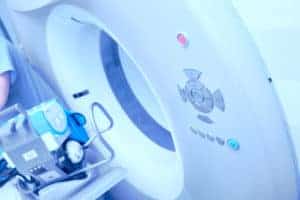
For more severe cases, the use of CT, MRI, and PET scans is often necessary. These three types of scans differ in how they work and what they can be used for, and it’s unlikely that you will need all three.
But what’s the difference between these types of imaging, and when should you have them?
CT Scans
A CT, CAT, or Computerized Tomography scan is an advanced form of an X-ray. It differs from traditional X-rays, though, because it uses multiple X-rays from various angles and positions to create a detailed image.
This image can be viewed from different angles, allowing doctors to get a much better idea of the damage. This technology provides a 3D picture of your injury, while a traditional X-ray is a standard 2D picture.
CT scans are also often more precise and can include more details, which makes them ideal for scanning for small tumors, detecting cancer before it has spread and grown, and identifying internal bleeding.
The one downside to CT scans is the same issue that has plagued X-rays: they do use radiation, which means you cannot have multiple CT scans done in a short period of time without risk.
MRIs
Having a Magnetic Resonance Imaging (MRI) procedure, unlike X-rays or CT scans, is completely radiation-free. Instead, it combines radio waves with magnets to create a unique image that can be used to view injuries and other issues within the body.
Those who have had a number of X-rays or CT scans may need to switch to having MRIs for a short time to prevent their body from being exposed to too much radiation. MRIs can be used to diagnose many of the same issues that CT scans do, so there’s rarely any downside to using one scan over another.
MRIs are often used in sports injuries because they are instrumental in diagnosing broken bones, torn ligaments, and other common sports injuries. You may need an MRI if your CT scan or X-ray doesn’t produce a clear enough image. This is because MRIs can show more detail. In some instances, your doctor may also want to have an MRI done to detect clots or tumors.
PET Scans
The third and newest form of imaging is the Positron Emission Tomography (PET) scan. A PET scan is different from the other two imaging techniques because it’s mainly used to look at your organs rather than bones.
Before the scan, you will be injected with a liquid that contains small radioactive particles. After these particles have spread through your body, you’ll go through a scanner that picks up the particles in the organs. This scanner sends the images it captures to a computer that creates usable images for doctors to study.
PET scans are generally used for illnesses related to blood, organs, and the brain. They can be used to help diagnose epilepsy and Alzheimer’s, but they usually aren’t used for common injuries or for cancer.
They can, however, be helpful in determining the success of a number of different cancer treatments. While PET scans do use radiation, they don’t use as much like X-rays or CT scans do, reducing the risk and allowing you to have multiple PET scans within a short amount of time without danger.
One thing to note is that traditional PET scan images are less detailed than the images created by MRIs or CT scans. Because of this, there is a hybrid PET-CT scan available that combines the two techniques and creates a very detailed, accurate image. The PET-CT scan is often used to help diagnose cancer.
Diagnosis Is Vital to Successful Treatment
If you have any injury, you must have the right type of imaging done in order to diagnose the damage and treat it appropriately. Here at AICA Orthopedics, we make use of the latest in imaging technology to do just that. Whether you need a CT scan, an MRI, or a PET scan, we can help. Contact us today to set up an appointment.
